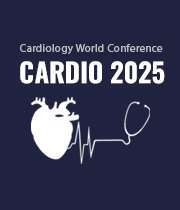Iris Panagiota Efthymiou, University of Greenwich, United Kingdom
Effective communication is critical in cardiology, where the stakes often involve life-altering decisions. This presentation explores the intersection of empathy and precision in communication, emphasizing the cardiologist’s role in fostering trust, understanding, and patie [....] » Read More


























































Title : Preventing sports-related cardiac arrest: Coronary artery calcium scoring stratifies the benefit of low-dose aspirin use for risk reduction
Arthur J Siegel, Massachusetts General Hospital, United States
While habitual endurance exercise such as training for a marathon is quintessentially cardioprotective, running such a race paradoxically confers a transiently increased risk for cardiac arrest and sudden death. The frequency of such events increased significantly in United State [....] » Read More
Title : Ex-situ organ perfusion and cardiac performance improvement
Y J H J Taverne, Erasmus University Medical Center, Netherlands
Cardiac transplantation remains the golden standard for patients with end-stage heart failure when therapeutic approaches and interventions fail to reverse HF progression. Traditionally, hearts are transplanted from brain-death (DBD) donors where the heart is beating at time of p [....] » Read More
Title : The past, present and future of AI in cardiology
Narendra Kumar, HeartbeatsZ Academy, United Kingdom
Artificial Intelligence (AI) is transforming cardiovascular medicine by enhancing diagnostic accuracy, treatment selection, and patient outcomes. Machine learning algorithms now analyse complex cardiac imaging with superhuman precision, detecting subtle patterns in echocardiogram [....] » Read More
Title : Personalized and Precision Medicine (PPM) as a unique healthcare model through biodesign-driven and inspired biotech, translational applications and cardiology-related marketing to secure the human healthcare, wellness and biosafety
Sergey Suchkov, N. D. Zelinskii Institute for Organic Chemistry of the Russian Academy of Sciences, Russian Federation
A new systems approach to diseased states and wellness result in a new branch in the healthcare services, namely, Personalized and Precision Medicine (PPM). To achieve the implementation of PPM concept, it is necessary to create a fundamentally new strategy based upon the recogni [....] » Read More
Title : VA ECMO as a bridge to OHT in the sickest of the sick cardiogenic shock patients
Peter Barrett, Piedmont Heart Institute, United States
To show the utility and benefit of VA-ECMO support in adults as a bridge to cardiac transplantation in the sickest of the sick cardiogenic shock patient population. VA-ECMO as bridge to LVAD or HT has significantly increased last 10-years. This approach has been controversial giv [....] » Read More
Title : Use of mitochondrial ROS inhibitor to protect coronary microvascular/endothelial function
Jun Feng, Alpert Medical School of Brown University, United States
Cardioplegic ischemia/reperfusion (I/R), hypoxia/re-oxygenation (H/R) and diabetes mellitus (DM) are associated with increased oxidative stress which contribute to coronary microvascular/endothelial dysfunction. Mitochondrial reactive oxidative species (mROS), a major source of R [....] » Read More
Title : Minimal invasive pediatric and adult congenital cardiac surgery
Y J H J Taverne, Erasmus University Medical Center, Netherlands
Full midline sternotomy remains the most common incision to correct congenital cardiac defects. Although many minimal invasive programs exist for the adult population worldwide, only a few centers have adopted such a program for the pediatric population. The rise of novel interve [....] » Read More
Title : Chinese herbal medicine effectively improves the composite outcome of repeat revascularization and in-stent restenosis in chronic coronary syndromes patients undergoing percutaneous coronary intervention
Xiaodi Ji, Fuwai Hospital, China
Background: Chinese herbal medicines (CHM) are gaining attention as complementary and alternative therapies for cardiovascular diseases. This study aims to explore the efficacy and favorable population of CHM in reducing the risk of major adverse cardiovascular events (MACE) in p [....] » Read More
Title : New probabilistic diagnostic aid tool for cardiac dynamics
Leonardo Juan Ramirez Lopez, Universidad Militar Nueva Granada, Colombia
Background: Probability theory and dynamical systems theory have been applied to cardiac dynamics, leading to the development of new methodologies that differentiate patients with normal medical diagnoses from those with chronic and acute conditions. Materials: A total of 120 [....] » Read More
Title : Mitral TEER as a bridge-to-recovery: A life-changing alternative to transplantation in advanced heart failure
Anoosha Nair, Harefield Hospital, United Kingdom
Advanced Heart Failure (AHF) remains a major clinical challenge due to its high morbidity and mortality. While Guideline-Directed Medical Therapy (GDMT) has improved patient outcomes, those with secondary Ischaemic Mitral Regurgitation (IMR) continue to have a poor prognosis. Tim [....] » Read More
Title : Ultrasound guided axillary vein puncture versus cephalic vein cutdown as venous access approach for implantation of CIED (Cardiac Implantable Electronic Devices)
Arva Zahid, University Hospitals Birmingham, United Kingdom
CIEDs are integral to managing cardiac conditions and different venous approaches have been used for their implantation. Ultrasound-Guided Axillary Vein Puncture (US-AVP) has emerged as new venous approach. This meta-analysis aims to systematically compare these approaches concer [....] » Read More
Title : The promising future of the unique translational tool to manage self-renewal of cardiac cells and to support regeneration in the post-infarction period
Sergey Suchkov, N. D. Zelinskii Institute for Organic Chemistry of the Russian Academy of Sciences, Russian Federation
The approaches securing cardiac regeneration in post-infarction period are not available to be practiced. The key problem is the identity of cells be born to generate functionally active cardiac myocytes replenishing those being lost during ischemia. With identification of reside [....] » Read More
Title : Atherogenic index of plasma as a risk stratification tool in patients with chronic coronary syndromes undergoing percutaneous coronary intervention
Xiaodi Ji, Fuwai Hospital, China
Background: The atherogenic index of plasma (AIP) is a new indicator associated with abnormalities in lipid metabolism. This study aims to explore the relationship between AIP and the risk of major adverse cardiovascular events (MACE) in patients with chronic coronary syndromes ( [....] » Read More
Title : A rare dual cardiac anomaly: Quadricuspid aortic valve and wenckebach AV block
Lilia Lagha, Frimley Health NHS Foundation Trust, United Kingdom
Quadricuspid Aortic Valve (QAV) is an exceptionally rare congenital cardiac anomaly characterized by the presence of four cusps instead of the usual three, often leading to valvular dysfunction. Equally intriguing, Mobitz type I second-degree Atrio Ventricular (AV) block, or Wenc [....] » Read More
Title : Cardiovascular biomarkers as predictors of early cognitive decline in heart failure patients: A literature review
Meghana Obarsu, Anglia Ruskin University, United Kingdom
Background: Cognitive decline is a frequently under-recognised yet debilitating complication in patients with Heart Failure (HF), impacting quality of life, self-management, and long-term prognosis. Recent studies reveal a mechanistic overlap between cardiovascular dysfunction an [....] » Read More
Title : Increased left ventricular mass as a marker of left ventricular hypertrophy in normotensive type 2 DM patients
Mohamed Mahmoud, Countess of Chester NHS Foundation Trust, United Kingdom
Diabetes is one of the most important metabolic conditions causing Left Ventricular (LV) dysfunction, one of which is Left Ventricular Hypertrophy (LVH). Increased Left Ventricular Mass (LVM) and Left Ventricular Mass Index (LVMI) are significant predictors of LVH. Aim This study [....] » Read More
Title : Transient ST-elevation MI diagnosed by holter monitoring
Nabihah Hussaini, University Hospital Lewisham, United Kingdom
Presentation: A 54-year-old woman was referred with an 8-week history of pressure sensations over the chest and epigastrium unrelated to exertion. She presented to the Emergency Department 4 weeks prior but self-discharged against medical advice due to the long wait time. Diag [....] » Read More
Title : A novel role for microcephaly - Associated scaffold protein WDR62 in postnatal cardiac physiology
Slade du Randt, The University of Queensland, Australia
Cardiovascular diseases are the leading causes of death worldwide. The proliferative capability of the contractile cells of the heart (cardiomyocytes), decreases after birth and damage to mature cardiomyocytes result in fibrotic scar formation driven by cardiac fibroblasts and di [....] » Read More
Title : Changes on sleep quality after treatment of mandibular advance device for sleep apnea: 24-hour holter-based cardiopulmonary coupling analysis
Jin Oh Na, Korea University Guro Hospital, Korea, Republic of
Background: The purpose of this study is to report the treatment effects of mandibular advance device (MAD) on patients with sleep apnea based on cardiopulmonary coupling (CPC) analysis. Method: Patients with mild to moderate obstructive sleep apnea were enrolled in a prospect [....] » Read More
Title : Assessing referral and participation in cardiac rehabilitation following coronary artery disease
Mohamed Mahmoud, Countess of Chester NHS Foundation Trust, United Kingdom
Background: Cardiac Rehabilitation (CR) is a well-established secondary prevention strategy that plays a pivotal role in improving cardiovascular outcomes for patients with Coronary Artery Disease (CAD). It has been shown to reduce mortality, recurrent cardiac events, and hospita [....] » Read More
Title : Use of SGLT2-i in treatment of established Coronary Artery Disease (CAD) in diabetic patients
Arva Zahid, University Hospitals Birmingham, United Kingdom
Introduction: To optimise patinet outcomes the National Institiute of Health and Care Excellence (NICE) has issues guidelines in Aug, 2022 recommending use of Sodium Glucose Co Transporter Inhibitor (SGLT-2i) in diabetic patients with established atherosclerotic coronary artery d [....] » Read More
Title : Pericardial decompression syndrome post pericardiocentesis in a case of miliary and disseminated tuberculosis in a young male presenting with cardiac temponade
Riya Hamid Mansuri, DY Patil University School of Medicine, India
Background: Pericardial effusion and cardiac tamponade encompass a clinical spectrum with diverse presentations. While significant pericardial effusions warrant clinical attention, emergent drainage is primarily indicated for patients exhibiting hemodynamic compromise. Cardiac ta [....] » Read More